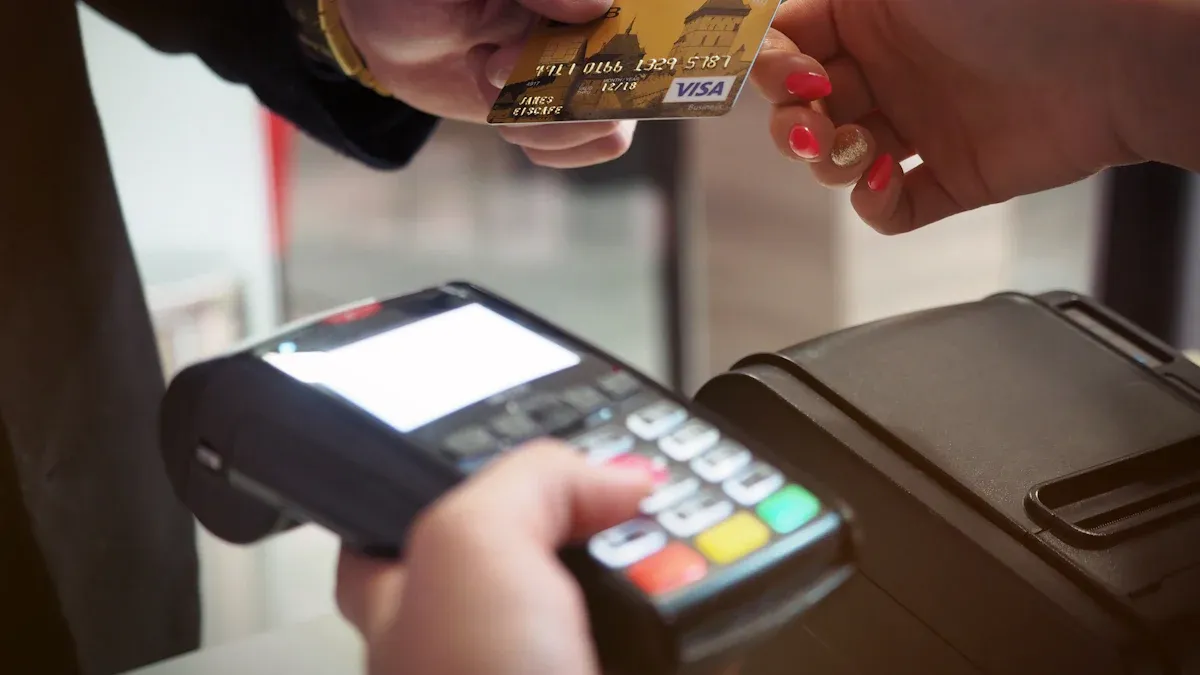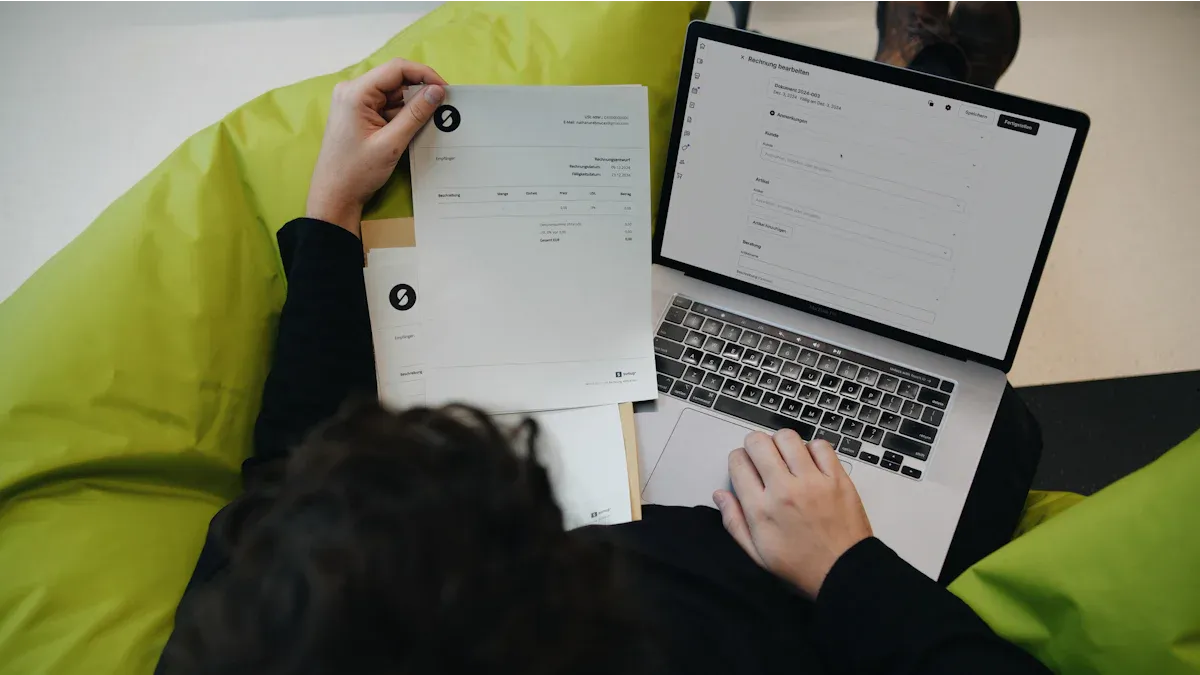- EasyCard
- Trade
- Help
- Announcement
- Academy
- SWIFT Code
- Iban Number
- Referral
- Customer Service
- Blog
- Creator
How to Correctly Understand and Use the Remittance Address? A Comprehensive Guide to International Payments

Image Source: pexels
Are you preparing to remit money to relatives or friends abroad? When filling in the “recipient address,” you may feel confused, unsure whether to enter the home address or the bank branch address. In fact, many remittance failures or delays stem from misunderstandings about the remittance address. These payments are often critical:
- Approximately 75% of international remittances are used for family support, such as paying bills or tuition fees.
- Another 2% to 15% of funds are used to fund or develop businesses.
This complete guide to international payments will thoroughly clarify the true meaning of addresses, teach you how to fill them accurately, and ensure funds arrive safely and quickly.
Key Takeaways
- International remittances require two types of addresses: the recipient address and the receiving bank address. The recipient address is used for identity verification, while the receiving bank address is used to locate the bank.
- Remittances require the use of specific bank codes. SWIFT Code is the global identification code for banks, and different countries have dedicated codes such as IBAN, ABA Routing Number, etc.
- When filling in remittance information, use all uppercase letters, avoid abbreviations, and carefully verify the postal code and country.
- Incorrect remittance information can lead to fund delays or losses. Confirm all information directly with the recipient and use a verification checklist.
- Before sending the remittance, carefully verify the recipient’s name, address, bank account number, and all codes to ensure the information is completely correct.
Remittance Addresses: Two Core Types
To successfully complete an international remittance, you first need to distinguish between two basic addresses: the recipient address and the receiving bank address. They serve completely different purposes, and filling in either incorrectly can lead to trouble.
Recipient Address (Beneficiary Address)
The recipient address refers to the address of the individual or company receiving the funds. The main purpose of this address is identity verification, helping the bank confirm that the recipient’s identity information matches the account to meet compliance requirements.
It usually comes in the following forms:
- Physical address: The most common form, including the full street, city, province/state, and postal code.
- P.O. Box address: Some institutions also accept a post office box as a contact address.
Important Tip: Prioritize physical addresses Many banks and remittance services (such as wire transfers) explicitly require you to provide the recipient’s physical address and prohibit the use of P.O. Box addresses. To avoid transfer rejection, be sure to request the recipient’s complete residential or office address.
Receiving Bank Address (Beneficiary Bank Address)
The receiving bank address refers to the address of the bank branch where the recipient’s account is located. This address is used to precisely locate the receiving bank in the complex international banking network, ensuring funds are routed correctly.
Note that this address is not necessarily the bank’s headquarters address. Some large banks designate a specific processing center address for all international wire transfers. For example, a major U.S. bank may require all international remittances to be sent to its specific address in California, regardless of the state where the recipient’s account is opened. Therefore, you must use the exact bank address provided by the recipient.
When to Fill in Which Address
So, in practice, which address should you fill in? The answer is simple: in most cases, both are required.
When conducting an international wire transfer through a bank, the remittance system usually requires you to provide both the recipient’s and the receiving bank’s addresses. This complete guide to international payments has prepared a clear table to help you understand their differences:
| Address Type | Fill-in Content | Core Function |
|---|---|---|
| Recipient Address | Recipient’s home or company address | Verify recipient identity, comply with anti-money laundering (AML) regulations |
| Receiving Bank Address | Address of the bank branch where the account is located | Locate the correct financial institution in the banking system, guide fund flow |
In summary, preparing both addresses before remitting is the safest approach.
Complete Guide to International Payments: Codes and Address Filling

Image Source: pexels
When preparing a cross-border remittance through online banking, you typically follow the process of “foreign exchange purchase → fill in remittance information → submit.” In the information filling step, in addition to the addresses discussed earlier, you will encounter various codes. These codes are the “universal language” of the international financial system, ensuring your funds can precisely reach the receiving bank and account.
Golden Rules for Filling Standards Before entering any information, please remember:
- Use all uppercase letters: Whether it’s the name, address, or code, use uppercase English letters entirely to avoid system recognition errors.
- Keep information complete: Do not use abbreviations. For example, writing “Street” as “St.” may cause issues.
- Verify postal code and country: Ensure the postal code and country name are accurate.
SWIFT Code: Global Universal Identification Code
SWIFT Code (also known as BIC Code) is the “ID number” for global banks. It is an international standard code used to identify specific banks in the global banking network. As of 2015, the SWIFT network has connected over 11,000 financial institutions in more than 200 countries and regions worldwide, making it the cornerstone of international remittances.
A complete SWIFT Code consists of 8 or 11 characters, structured as follows:
- AAAA (4 letters): Bank code, representing the name of the financial institution.
- BB (2 letters): Country code, representing the country where the bank is located.
- CC (2 letters or numbers): Location code, used to locate the city of the bank’s headquarters.
- DDD (3 letters or numbers): Branch code (optional). If omitted or shown as “XXX,” it represents the bank’s head office.
For example, a code BANKUS33XXX clearly indicates the bank, country, city, and head office.
U.S. Remittances: ABA Routing Number
If you are remitting to a U.S. bank account, the ABA Routing Number (also known as routing number) is essential information. This is a 9-digit code specifically used to identify U.S. banks.
Each part of it has a specific meaning, collectively ensuring funds are routed to the correct financial institution:
- First 4 digits: Identify the Federal Reserve district where the bank is located.
- Digits 5 to 8: Identify the specific bank institution.
- 9th digit: A check digit that verifies the accuracy of the first 8 digits through an algorithm to prevent input errors.
Important Tip:ABA numbers for ACH and wire transfers may differ You need to pay special attention that U.S. banks may use different ABA numbers for different types of transfers. The ABA number printed on your checkbook is mainly for paper checks and some electronic transfers (ACH), while international wire transfers may require a dedicated ABA number. Using the wrong one may cause remittance failure or delay. Before remitting, be sure to confirm with the recipient which ABA number they should provide.
European Remittances: IBAN is Key
When remitting to most European countries, IBAN (International Bank Account Number) is the absolute star. It integrates country, bank, branch, and personal account information into a standardized long string, greatly reducing error rates.
The advantages of IBAN include:
- Reducing errors: Built-in check digits can instantly verify the validity of the number, avoiding remittance failures due to typing errors.
- Improving efficiency: The standardized format allows banks to process automatically, speeding up fund arrival.
- Precise positioning: It directly points to the final personal account, not just the bank.
IBAN lengths vary by country, ranging from 18 to 31 digits. For example, Germany’s IBAN is 22 digits, while France’s is 27 digits.
When remitting to countries requiring IBAN, you usually need to provide the SWIFT Code as well. This complete guide to international payments recommends preparing both.
UK Remittances: Sort Code
When remitting to a UK bank account, you will encounter the Sort Code. This is a 6-digit code, usually written in the format 12-34-56. Its role is to identify the specific bank and branch within the UK banking system.
- First two digits: Usually used to identify the bank itself (such as Barclays, HSBC, etc.).
- Last four digits: Used to identify the exact branch where the account is located.
For domestic UK transfers, the Sort Code and recipient account number are sufficient. But for international remittances, you must also provide the recipient’s IBAN and the bank’s SWIFT Code to ensure compliance with international standards.
Canadian Remittances: Transit Number
Remitting to Canada requires providing a routing number, which is composed of the Institution Number and Transit Number.
- Institution Number: A 3-digit code used to identify the bank (such as RBC, TD, etc.).
- Transit Number: A 5-digit code used to identify the specific bank branch.
These two numbers have different combination formats in different scenarios, regulated by the Canadian Payments Association (CPA):
| Payment Type | Format | Example (Institution 003, Branch 12345) |
|---|---|---|
| Paper Check | XXXXX-YYY | 12345-003 |
| Electronic Transfer (EFT) | 0YYYXXXXX | 000312345 |
For electronic remittances, you must use the second format, adding a 0 before the 3-digit institution number and then connecting the 5-digit branch number.
Australian Remittances: BSB Number
If you are paying to an Australian account, the BSB (Bank-State-Branch) number is key information. This is a 6-digit code used to identify the bank, state, and branch in Australia.
The BSB number structure is very clear, for example 082-902:
- 08: Bank code (for example, this is the code for National Australia Bank NAB).
- 2: State code (for example, 2 represents the branch is in the Australian Capital Territory).
- 902: Branch code, pointing to the specific business outlet.
Similar to the UK, BSB is mainly used for domestic Australian payments. For international remittances to Australia, in addition to providing the BSB number and recipient account number, you must also provide the bank’s SWIFT Code. This complete guide to international payments reminds you that missing any item may prevent your funds from arriving smoothly.
Avoid Pitfalls: Consequences and Verification Checklist

Image Source: unsplash
You now understand the meaning of all codes and addresses, but the real challenge is ensuring every detail is accurate. A small mistake can make your remittance journey full of obstacles. This section will explain the cost of filling errors and provide an ultimate verification checklist to help you avoid all pitfalls.
The Cost of Filling Errors
Filling in incorrect information is not just a minor inconvenience; it directly leads to dual losses of time and money.
First, you will face financial losses. If the remittance fails due to incorrect information you provided, the remittance service provider may deduct related fees when refunding.
- Third-party fees: Intermediary banks may have already charged handling fees (e.g., $5), which will be deducted from your refund.
- Re-remittance fee: If you want to correct the information and resend, the service provider can charge you a new transfer fee (e.g., $10).
- Taxes: If the service provider has already paid related taxes on your behalf, this money may not be refundable.
Second, your payment will be delayed or even frozen. Bank automated systems are very sensitive to information errors. Even a slight difference in the recipient’s name spelling from the account record, or a single digit error in the account number, can trigger compliance alerts, leading to:
- Payment blocked: The bank requires manual review to verify whether funds are flowing to the intended recipient.
- Compliance review: If recipient information resembles any sanctions list (such as OFAC), the transaction will be frozen for in-depth investigation.
How to Obtain Correct Information
The only reliable way to obtain correct information is to request it directly from the recipient. Do not guess or rely on outdated records.
Safety First: Beware of Email Scams Never accept new remittance information solely via email. Hackers may intercept or forge emails. The safest practice is to call the recipient directly and verbally confirm the bank account number, address, and all codes.
Once you receive the information, you can use some online tools for secondary verification, such as SWIFT code checking tools provided by Bank.Codes or The SWIFT Codes.com. But remember, these tools can only verify the format of the code and the corresponding bank, not confirm whether it fully matches the recipient’s personal account. Final confirmation still relies on the recipient.
Ultimate Pre-Remittance Verification Checklist
Before clicking the “send” button, take a few minutes to go through this ultimate checklist prepared for you by the complete guide to international payments, checking item by item.
| Verification Item | Key Points |
|---|---|
| Recipient Full Name | Ensure the pinyin/English name exactly matches the official name on the bank account, without abbreviations. |
| Recipient Full Address | Fill in the complete physical address (street, city, postal code), do not use a P.O. Box. |
| Receiving Bank Account Number | Double-check every digit; this is key to whether funds can be credited. |
| Receiving Bank Full Name | Use the bank’s official full name, avoid abbreviations. |
| Receiving Bank Address | Fill in the branch address provided by the recipient or the designated processing center address. |
| SWIFT Code | Confirm the 8- or 11-digit code is accurate, especially the last three digits for the branch. |
| Country-Specific Codes | Depending on the destination country, check if IBAN (Europe), ABA (U.S.), Sort Code (UK), etc., have been filled. |
Developing the habit of using this checklist before every remittance can maximize the safety and speed of your funds arriving.
The success of international remittances lies in the details. The accuracy of addresses and codes is crucial; a single character error can put your funds in jeopardy. Develop good habits and use the verification checklist from this complete guide to international payments as your standard operating procedure before every remittance.
Remember, as long as you master the correct concepts and methods, international remittances can also become simple and safe.
FAQ
Can I fill in the bank’s headquarters address as the receiving bank address?
Usually not. You should prioritize the specific branch address provided by the recipient or the bank’s designated international remittance processing center address. Filling in the headquarters address may cause your remittance to be delayed or returned because funds need to be precisely routed to the correct branch.
What happens if the SWIFT Code and bank address do not match?
When processing remittances, bank systems prioritize the SWIFT Code. If the code is correct, funds can usually reach the correct bank. But an incorrect address may trigger a compliance review, causing payment delays. To ensure absolute safety, you should ensure both are accurate.
Why was my remittance deducted extra fees?
This fee is likely charged by an intermediary bank. For example, when remitting from the U.S. to a licensed bank in Hong Kong, funds may need to pass through an intermediary bank.
The intermediary bank will deduct a service fee from the remittance amount (e.g., $15), which is not charged by the receiving bank or remittance institution.
Can I provide only IBAN without the SWIFT Code?
This is not recommended. Although IBAN already contains most account information, many bank systems still require both IBAN and SWIFT Code to process international remittances.
- IBAN: Precisely locates the personal account.
- SWIFT Code: Precisely locates the bank institution.
Providing both ensures the fastest and smoothest remittance process.
*This article is provided for general information purposes and does not constitute legal, tax or other professional advice from BiyaPay or its subsidiaries and its affiliates, and it is not intended as a substitute for obtaining advice from a financial advisor or any other professional.
We make no representations, warranties or warranties, express or implied, as to the accuracy, completeness or timeliness of the contents of this publication.




Contact Us
Company and Team
BiyaPay Products
Customer Services
is a broker-dealer registered with the U.S. Securities and Exchange Commission (SEC) (No.: 802-127417), member of the Financial Industry Regulatory Authority (FINRA) (CRD: 325027), member of the Securities Investor Protection Corporation (SIPC), and regulated by FINRA and SEC.
registered with the US Financial Crimes Enforcement Network (FinCEN), as a Money Services Business (MSB), registration number: 31000218637349, and regulated by FinCEN.
registered as Financial Service Provider (FSP number: FSP1007221) in New Zealand, and is a member of the Financial Dispute Resolution Scheme, a New Zealand independent dispute resolution service provider.




















